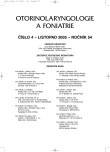Xerostomia: Etiology, Therapeutic Possibilities, Recommendation to Patients
Authors:
J. Lukáš; D. Veselý
Authors‘ workplace:
Katedra otorinolaryngologie IPVZ, Praha
přednosta prof. MUDr. J. Betka, DrSc.
; Klinika ORL a chirurgie hlavy a krku 1. LF UK a FN Motol, Praha
Published in:
Otorinolaryngol Foniatr, 54, 2005, No. 4, pp. 206-210.
Category:
Original Article
Overview
Summary:
Xerostomia, „dry mouth“ develops due to decreased saliva production. It follows to disorders of mastication, swallowing, taste and speech, increased formation of caries and fungal infections of oral cavity. It can be caused by iatrogenic reasons (after drugs, post-irradiation) or it can be associated with other disease of salivary glands, autoimmune diseases, infectious, endocrine or psychiatric diseases. The authors describe clinical consequences of creased saliva production and present practical stimuli for examination and treatment of the cases described.
Key words:
xerostomia, dry mouth, salivary glands.
Labels
Audiology Paediatric ENT ENT (Otorhinolaryngology)Article was published in
Otorhinolaryngology and Phoniatrics

2005 Issue 4
Most read in this issue
- Xerostomia: Etiology, Therapeutic Possibilities, Recommendation to Patients
- Shaver (Microdebrider) in Otorhinolaryngology
- Langerhans‘ Cell Histiocytosis and Its Manifestation in Temporal Bone (Eosinophilic Granuloma of the Temopral Bone)
- Cholesteatoma and Fistula of Bone Labyrinth
